Several species of grouse inhabit my backyard (Wrangell/St. Elias National Park and Preserve), Alaska. Above, sharp-tailed grouse.
video link below: Grouse in my backyard

Several species of grouse inhabit my backyard (Wrangell/St. Elias National Park and Preserve), Alaska. Above, sharp-tailed grouse.
video link below: Grouse in my backyard
Check out my owl photos in June/July 2025 RANGER RICK by clicking link below.
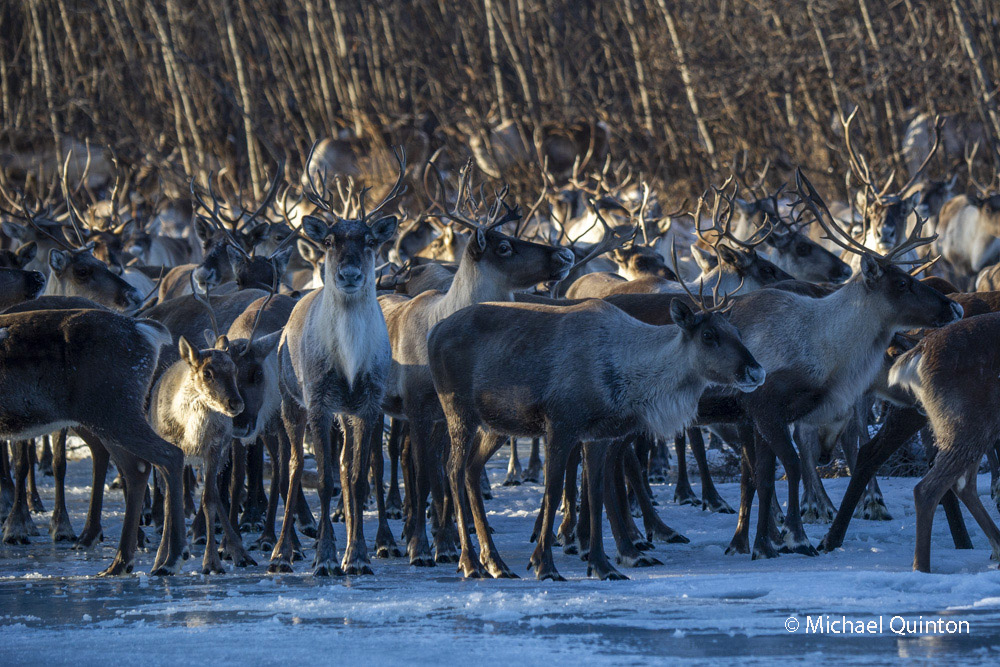 For two weeks I’d waited along this frozen river in the hopes of photographing the semi-annual caribou migration. Altogether I saw about two hundred caribou, a mere trickle compared to some years. One large group (above) had close to one hundred fifty caribou and the remaining stragglers were in pairs or small groups. The bulk had passed to the west of here earlier.
For two weeks I’d waited along this frozen river in the hopes of photographing the semi-annual caribou migration. Altogether I saw about two hundred caribou, a mere trickle compared to some years. One large group (above) had close to one hundred fifty caribou and the remaining stragglers were in pairs or small groups. The bulk had passed to the west of here earlier.
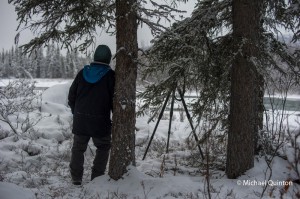 I knew from past migrations that the freezing rivers naturally funnel the caribou to this big bend in the Copper River Basin. The river, frozen on both sides, was still open in most places down the middle. I had located four likely places on the big bend where caribou had crossed, places with enough cover for a photo ambush. I moved between my ambush points to stay warm and pack down the trail between them so I could quickly move from one to another. On most days I saw no caribou. Though painfully slow, action could come at any moment.
I knew from past migrations that the freezing rivers naturally funnel the caribou to this big bend in the Copper River Basin. The river, frozen on both sides, was still open in most places down the middle. I had located four likely places on the big bend where caribou had crossed, places with enough cover for a photo ambush. I moved between my ambush points to stay warm and pack down the trail between them so I could quickly move from one to another. On most days I saw no caribou. Though painfully slow, action could come at any moment.
And when caribou are suddenly bearing down on my hide, I start forgetting things. Things like warm cabin and cold feet. And exactly, what is it I’m supposed to be doing with the camera? Luckily symptoms of buck fever are temporary.
 Of course more often than not the caribou would decide to cross where I wasn’t. With tripod and camera over my shoulder I hurried down my trail trying to stay in camera range. Out of time and breath, I planted the tripod like a mono-pod into the snow and clicked away as they plunged in and swam across.
Of course more often than not the caribou would decide to cross where I wasn’t. With tripod and camera over my shoulder I hurried down my trail trying to stay in camera range. Out of time and breath, I planted the tripod like a mono-pod into the snow and clicked away as they plunged in and swam across.
When I first noticed the caribou calf, it was in the river being carried past me by the current. He managed to climb onto an ice island in the middle of the river. After a couple of minutes he struggled to stand. Even though exhausted, the six month old calf, separated from his mom and in maximum migration mode, was pressed by the urge to keep going. Walking to the edge of the ice he stepped in with a plop and swam across the ten feet of open water but did not attempt to climb out. Instead he turned back to the island, climbed out, laid down and curled up. I stayed hidden knowing if he saw me now he might panic. The calf was in trouble and travel would wait. A rest and recharge now could only help tip the balance in his favor. Half an hour later the six month-old calf was still asleep on the ice. As I slowly moved away and headed home, I had a hunch this young caribou was a survivor.
 A pair of gray jays have finished their nest by early April.
A pair of gray jays have finished their nest by early April.
I first saw the gray jays as they flew across the road in front of me. They both carried loads of building materials in their bills. The next day I went searching for their nest. It was rather easy to find as they were both busy with construction. The nest was about twenty feet high in a medium-sized black spruce. They had completed a loose bowl of dry spruce twigs and were currently engaged with stuffing this framework with insulation. The pair gathered black, grizzly hair lichens as well as spruce grouse feathers. But their most prized finds were the long soft plumes of the northern hawk owl. After delivering a load of insulation, the birds would hop into the nest and push with bills and feet as they rotated around in the nest, fitting and forming it to just the right shape. The female begins sitting on the nest and a week later her clutch of spotted eggs is complete. The pair is quiet at the nest site and does not attract attention of those nest raiders, magpies and ravens. When a red squirrel was spotted nearby it was dive-bombed by the male gray jay and driven away.
The female begins sitting on the nest and a week later her clutch of spotted eggs is complete. The pair is quiet at the nest site and does not attract attention of those nest raiders, magpies and ravens. When a red squirrel was spotted nearby it was dive-bombed by the male gray jay and driven away.
 For nearly three weeks the female incubated her four eggs. A few times a day she will leave the nest but only for a few minutes, perhaps to drink.
For nearly three weeks the female incubated her four eggs. A few times a day she will leave the nest but only for a few minutes, perhaps to drink.
 The male gray jay shows up at the nest about once an hour or so to feed his mate.
The male gray jay shows up at the nest about once an hour or so to feed his mate.
 Laying eggs is an energy drain and the female spends hours sleeping.
Laying eggs is an energy drain and the female spends hours sleeping.
 Early nesting grays jays must be able to handle cold, wet conditions in their Alaskan habitat.
Early nesting grays jays must be able to handle cold, wet conditions in their Alaskan habitat.
 Both adults help feed the quickly growing gray jay chicks. Gray jays store amazing amounts of food including carrion and I wondered if they would feed their cached supplies to their chicks. But Instead they foraged the ground for insects and larva, much better food for the new chicks.
Both adults help feed the quickly growing gray jay chicks. Gray jays store amazing amounts of food including carrion and I wondered if they would feed their cached supplies to their chicks. But Instead they foraged the ground for insects and larva, much better food for the new chicks.
 As the chicks grew the gray jays cached stores of carrion became more important. And it quickly became apparent that the nest would never hold four growing chicks for long. By the time the chicks were about two weeks old, they jostle for the best position at the nest. I witnessed deliberate attempts by the larger chicks to force their smaller siblings out. One morning there were just two chicks left in the nest. Below the nest on the ground were the missing chicks, both dead. From human eyes, a tragic event. But for nature, another one of those mysteries of survival.
As the chicks grew the gray jays cached stores of carrion became more important. And it quickly became apparent that the nest would never hold four growing chicks for long. By the time the chicks were about two weeks old, they jostle for the best position at the nest. I witnessed deliberate attempts by the larger chicks to force their smaller siblings out. One morning there were just two chicks left in the nest. Below the nest on the ground were the missing chicks, both dead. From human eyes, a tragic event. But for nature, another one of those mysteries of survival.
Come July of this year the name of the gray jay will change once again. They will officially be known as the Canada jay. And like camp robber and whiskey jack, gray jay will be just another nickname used to describe this gray-colored jay of the northern forests.
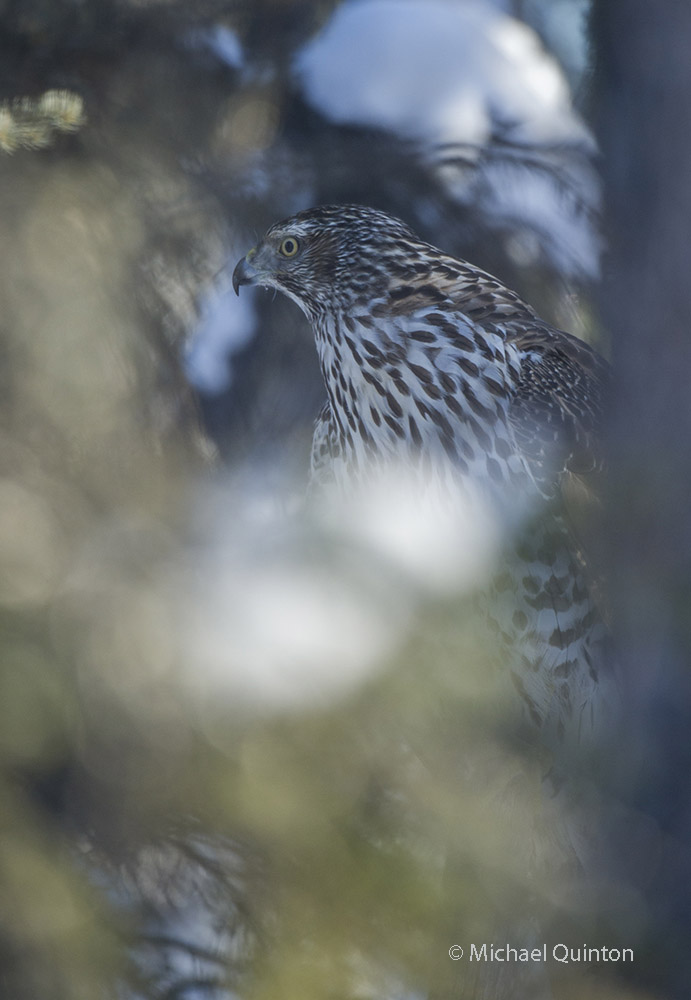 From a perch in a stand of stunted black spruce, a well camouflaged immature northern goshawk stalks its prey. Their short, wide wings and long tail give it both speed and manoeuverability to pursue prey in the forest. No small bird or mammal is safe from a sudden ambush, but this winter the large accipiters key on snowshoe hares.
From a perch in a stand of stunted black spruce, a well camouflaged immature northern goshawk stalks its prey. Their short, wide wings and long tail give it both speed and manoeuverability to pursue prey in the forest. No small bird or mammal is safe from a sudden ambush, but this winter the large accipiters key on snowshoe hares.
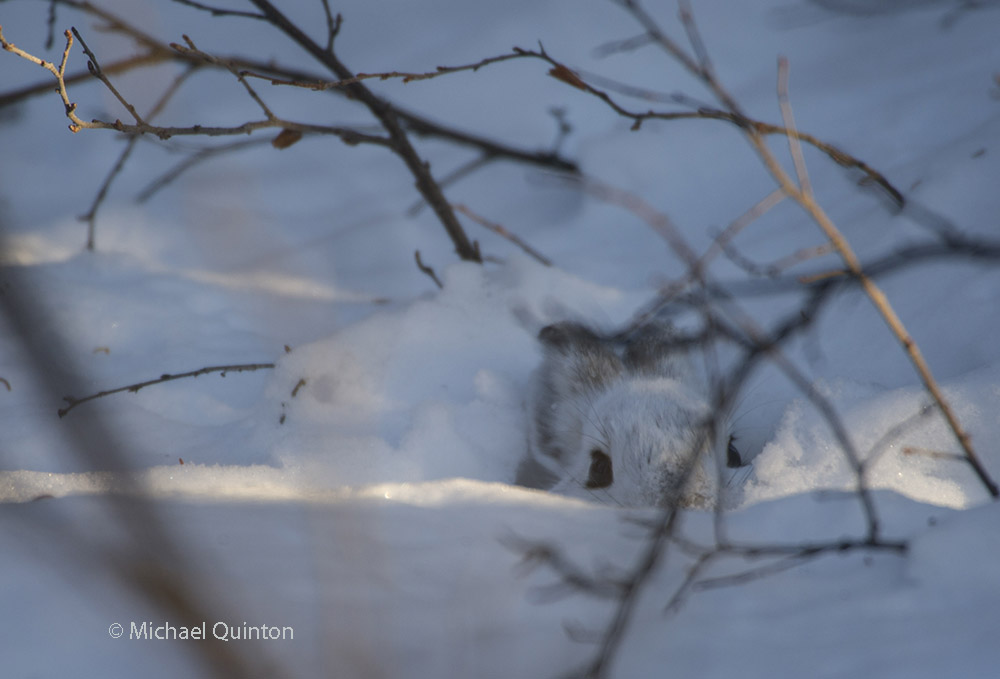 The snowshoe hare has perfected the art of camouflage, but as an extra defense against the goshawks, they often use snow burrows. But the snowshoe hares’ best defense against the sudden attacks by goshawks is its nocturnal behavior.
The snowshoe hare has perfected the art of camouflage, but as an extra defense against the goshawks, they often use snow burrows. But the snowshoe hares’ best defense against the sudden attacks by goshawks is its nocturnal behavior.
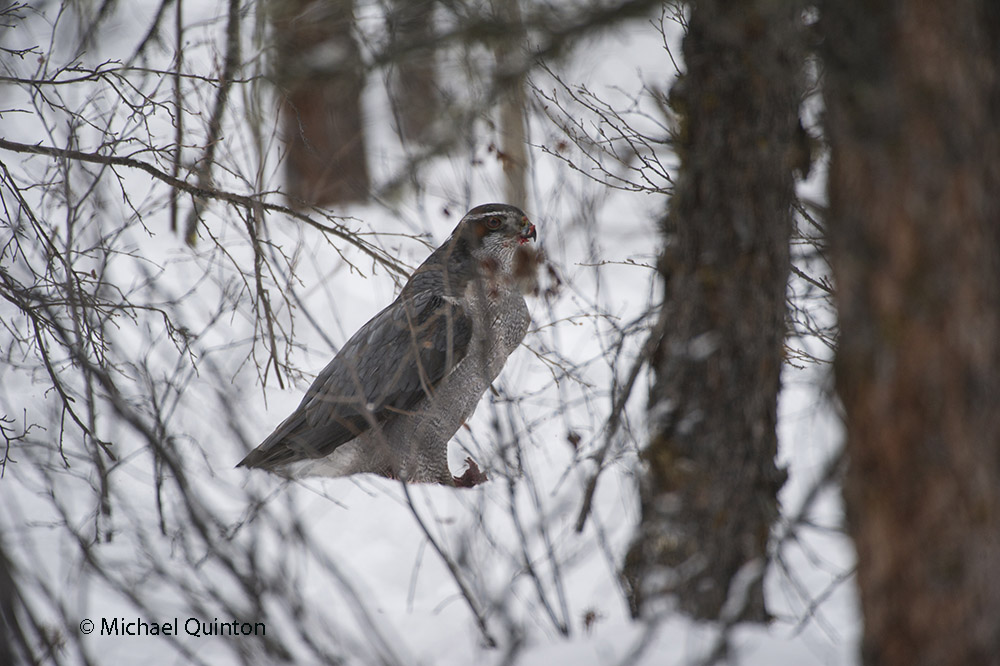 An adult northern goshawk feeds on a snowshoe hare.
An adult northern goshawk feeds on a snowshoe hare.
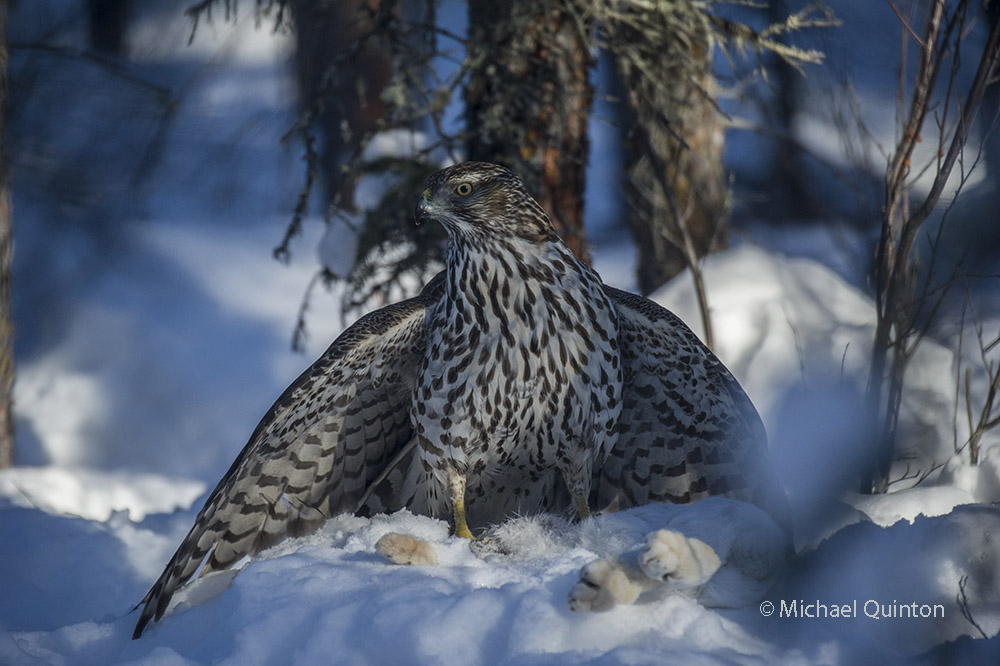 As I photographed a snowshoe hare this immature northern goshawk suddenly appeared out of the blue shadows and killed my photo subject. She mantles her prey with powerful wings.
As I photographed a snowshoe hare this immature northern goshawk suddenly appeared out of the blue shadows and killed my photo subject. She mantles her prey with powerful wings.
 Often northern goshawks show little fear of humans. When I approached it flew a few yards away but quickly returned to its prey. The goshawk fed for nearly an hour leaving only the feet, fur, guts, head and large bones.
Often northern goshawks show little fear of humans. When I approached it flew a few yards away but quickly returned to its prey. The goshawk fed for nearly an hour leaving only the feet, fur, guts, head and large bones.
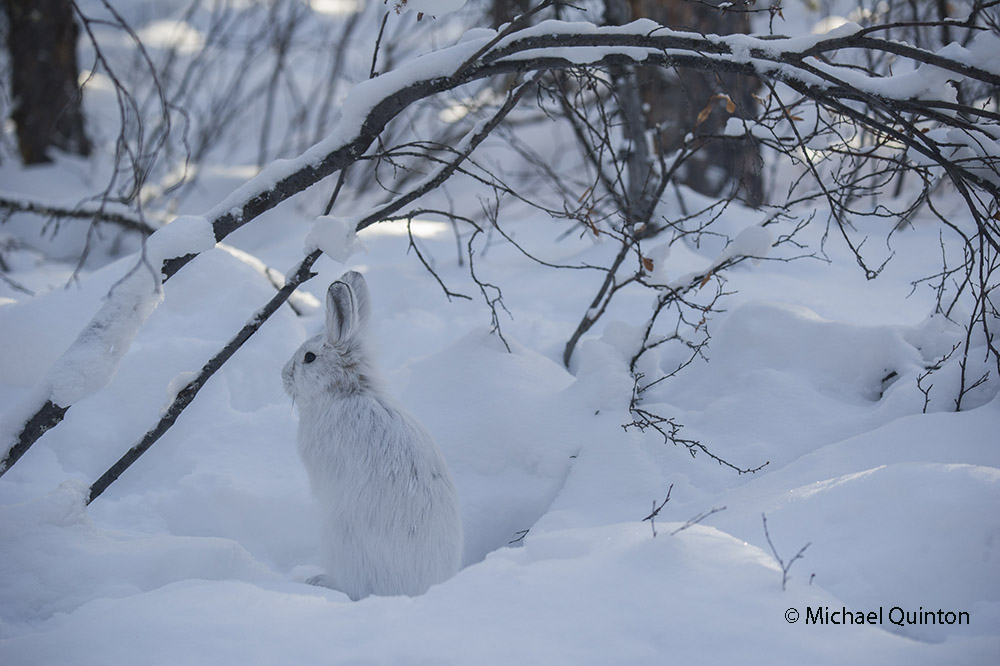 While the snowshoe hare population is near its peak this year, their primary predators populations (northern goshawk, lynx, coyote and great horned owl) are also peaking. And this heavy predation will inevitably cause the next snowshoe hare population crash.
While the snowshoe hare population is near its peak this year, their primary predators populations (northern goshawk, lynx, coyote and great horned owl) are also peaking. And this heavy predation will inevitably cause the next snowshoe hare population crash.
 For months, over two nesting seasons I spent nearly every day in the company of northern goshawks. Slowly they would reveal their secret lives.
For months, over two nesting seasons I spent nearly every day in the company of northern goshawks. Slowly they would reveal their secret lives.
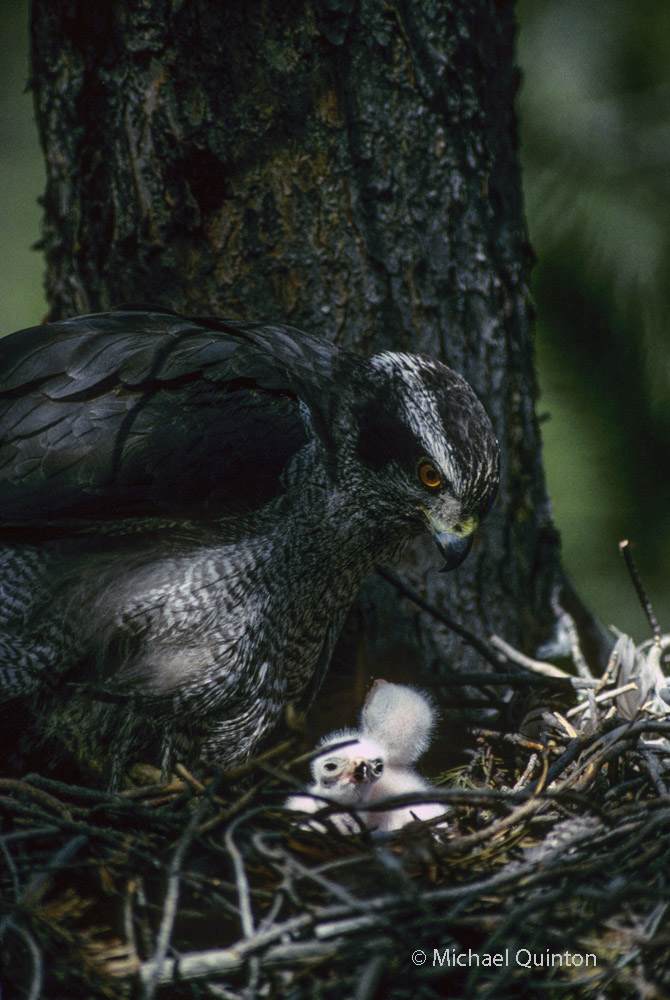 High in the canopy a female tends to her day old chicks.
High in the canopy a female tends to her day old chicks.
After the chicks hatch, northern goshawks become very aggressive at their nests. By visiting the nesting territory on a daily basis, starting early in the nesting season I seemed to have gained the trust of the goshawks. By building my blind near their nest under the cover of darkness, wearing the same clothes everyday and never disturbing the nest, I was able to climb into my photo blind or walk around the forest below unmolested.
The great female goshawk rose up from her eggs and stepped to the edge of her three-foot wide nest. Eyes of blood locked onto her target. Diving headfirst off the nest, she pumped her wings quickly accelerating to attack speed. Long tail feathers flared and pivot, sending the goshawk speeding around the base of a large douglas fir and crashing into the understory. Squealing in terror, a red squirrel jumped to the trunk and instinctively darted to the opposite side, sticking like velcro to the rough, dry bark, then squirrel shot up the trunk into the canopy. Again the goshawk attacked. Going up, the squirrel was faster but on the way back down the goshawk closed the distance.
Among the thick branches of the canopy the squirrel had the edge, but not by much. Using feet, bill and wings, the goshawk literally swam through the boughs. Desperate to lose the hawk, the squirrel spiraled up the nest tree and right over those precious eggs, before jumping to an adjacent tree. The squirrel somehow missed being snagged by those talons, utilizing unearthly tricks of speed and anti-gravity. I could keep track of the chase through the various observation and lens slits cut into the photo blind, but the action was much too quick and hard to follow so I missed getting any photos. It was inevitable I guess, when I felt the squirrel coming up my blind tree, the gos riding his wind. A vision of the squirrel taking refuge up my pant leg was suddenly a painful possibility. Just as the squirrel shot inside the blind I yelled and smacked the side of the blind. Luck was cheap that June morning. After a couple of quick laps around the legs of me and my tripod, the squirrel dashed back out and jumped to the next tree about five feet away.
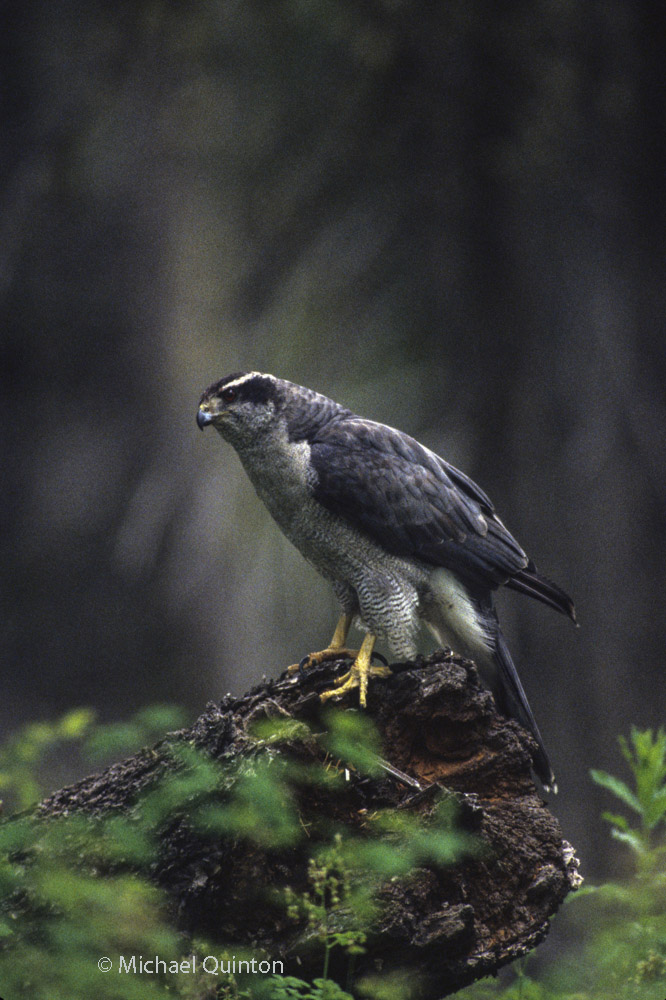 Slamming through the branches with little regard for its plumage, the gos didn’t let up. But the squirrel had a little luck of his own stashed away. Running headfirst down the trunk, the squirrel made an Olympic jump 25 feet from the ground. Bouncing off the forest floor the squirrel made for thicker scenery. After orbiting several more big trees and an amazing sling-shot the squirrel made it to a thick jungle of downfall. For the next 30 minutes, the goshawk perched 20 feet below her nest and preened. The squirrel barked, chattered and buzzed and told the world what he thought of goshawks nesting in his five acres.
Slamming through the branches with little regard for its plumage, the gos didn’t let up. But the squirrel had a little luck of his own stashed away. Running headfirst down the trunk, the squirrel made an Olympic jump 25 feet from the ground. Bouncing off the forest floor the squirrel made for thicker scenery. After orbiting several more big trees and an amazing sling-shot the squirrel made it to a thick jungle of downfall. For the next 30 minutes, the goshawk perched 20 feet below her nest and preened. The squirrel barked, chattered and buzzed and told the world what he thought of goshawks nesting in his five acres.
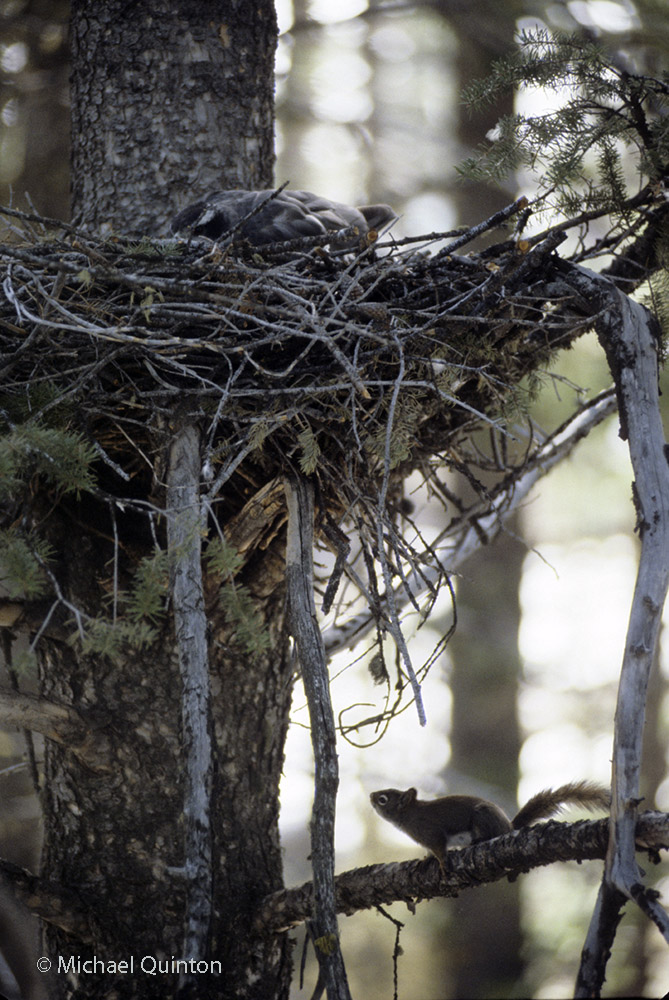 Three weeks earlier, the goshawk had calmly sat on her eggs while this same squirrel climbed the nest tree, dug into the bottom of the nest to find and nibble on mushrooms. I guess it seemed like the perfect place to dry mushrooms.
Three weeks earlier, the goshawk had calmly sat on her eggs while this same squirrel climbed the nest tree, dug into the bottom of the nest to find and nibble on mushrooms. I guess it seemed like the perfect place to dry mushrooms.
A pair of northern hawk owls check out the view from atop a prospective nesting cavity. Hawk owls, like other owls, do not build a nest but use natural cavities and bowled out snags. The male establishes a territory that includes potential nests sites, but it seems to be the female who makes the final choice of snags.
After settling on another snag, the female incubates her eggs. Hawk owls nest early, usually in late April and will endure winter conditions.
Check out my photo story about northern hawk owls in the May 2018 issue of RANGER RICK, Just click the link below.
https://www.youtube.com/watch?v=XvzyMyCI59g
Snowshoe hares in winter feeding on dry alder leaves.
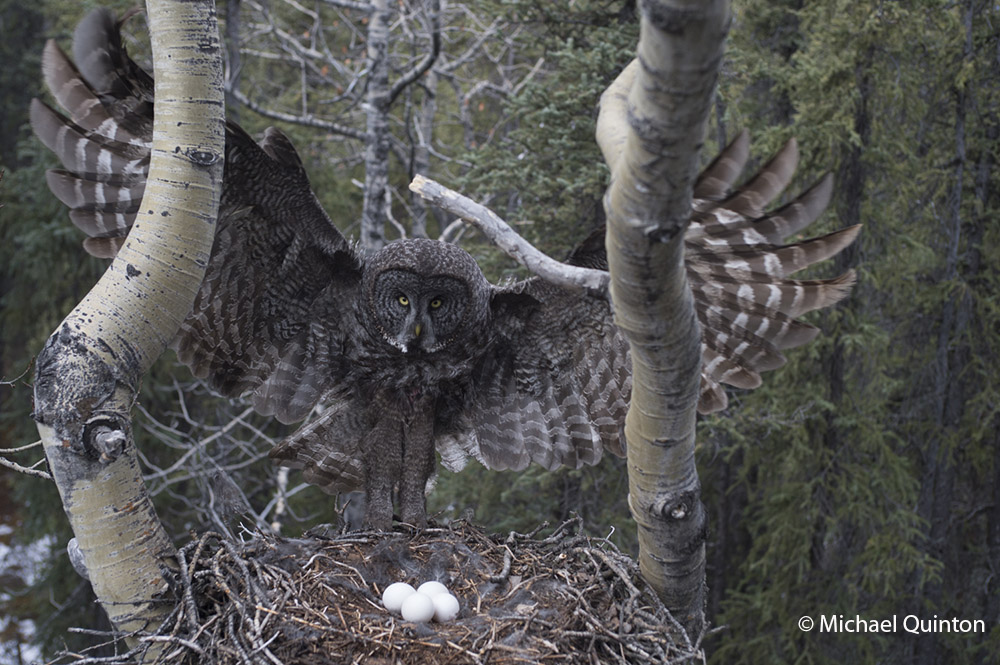 A female great gray owl spreads her wings as she gently lands on the edge of her nest to resume incubating her four eggs. For two months this nest is the nucleus of activity for a pair of great gray owls. Owls do not build their own nests. Instead they use a variety of ready-made and vacant nests, like this one built many years before by northern goshawks. The great grays I had photographed three decades ago in Idaho prefered the bowled out tops of large broken pine trees for their nests.
A female great gray owl spreads her wings as she gently lands on the edge of her nest to resume incubating her four eggs. For two months this nest is the nucleus of activity for a pair of great gray owls. Owls do not build their own nests. Instead they use a variety of ready-made and vacant nests, like this one built many years before by northern goshawks. The great grays I had photographed three decades ago in Idaho prefered the bowled out tops of large broken pine trees for their nests.
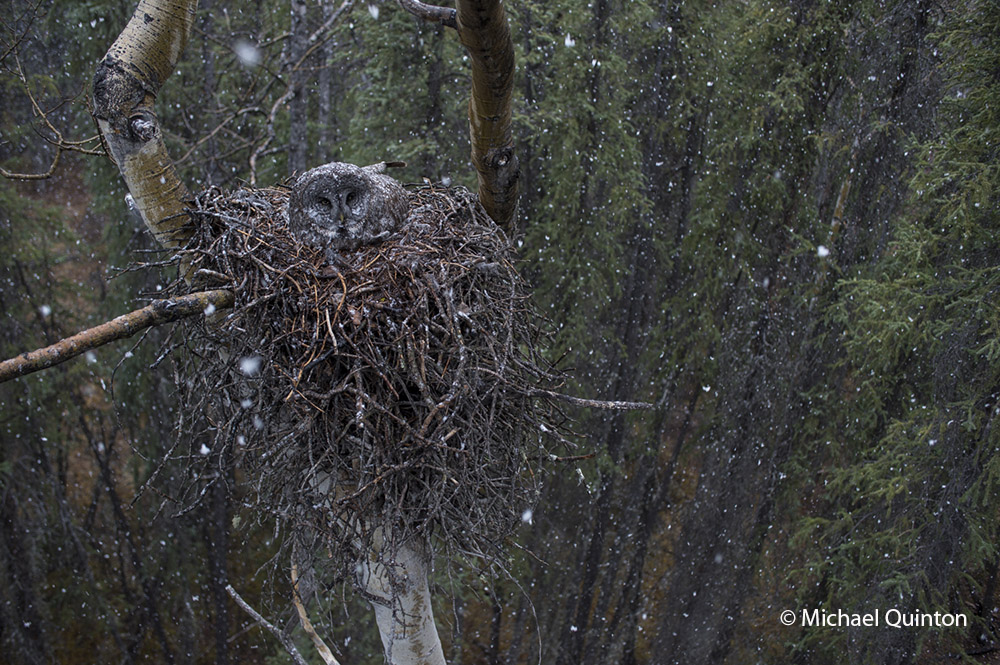 Eggs laid in the third week of April must be protected from the weather, as incubation begins with the first egg. The female does all the incubating and will sit on her eggs for thirty days.
Eggs laid in the third week of April must be protected from the weather, as incubation begins with the first egg. The female does all the incubating and will sit on her eggs for thirty days.
 To gain access to the nesting great grays, more than fifty feet above the forest floor, I scabbed two long extensions ladders together and added an additional extension using two by fours. I had located the nest thirteen years ago. The three-foot wide nest was built by northern goshawks in a towering quaking aspen. Every spring I’d hike to the remote nest site to check its status. Goshawks had used the nest only once during the last thirteen years.
To gain access to the nesting great grays, more than fifty feet above the forest floor, I scabbed two long extensions ladders together and added an additional extension using two by fours. I had located the nest thirteen years ago. The three-foot wide nest was built by northern goshawks in a towering quaking aspen. Every spring I’d hike to the remote nest site to check its status. Goshawks had used the nest only once during the last thirteen years.
From my self-imposed confinement in the lofty, swaying photo blind, I witnessed much more than just the daily activities of the great gray owls. The female owl and I watched red squirrels, that rarely seen red squirrel predator, the marten, groups of migrating caribou, and a variety of bird life. Early one morning, not long after arriving, a huffing grizzly bear sow and yearling cub who had caught my scent quickly moved off beneath the blind. Once a curious cow moose who could hear my camera clicking finally looked up.
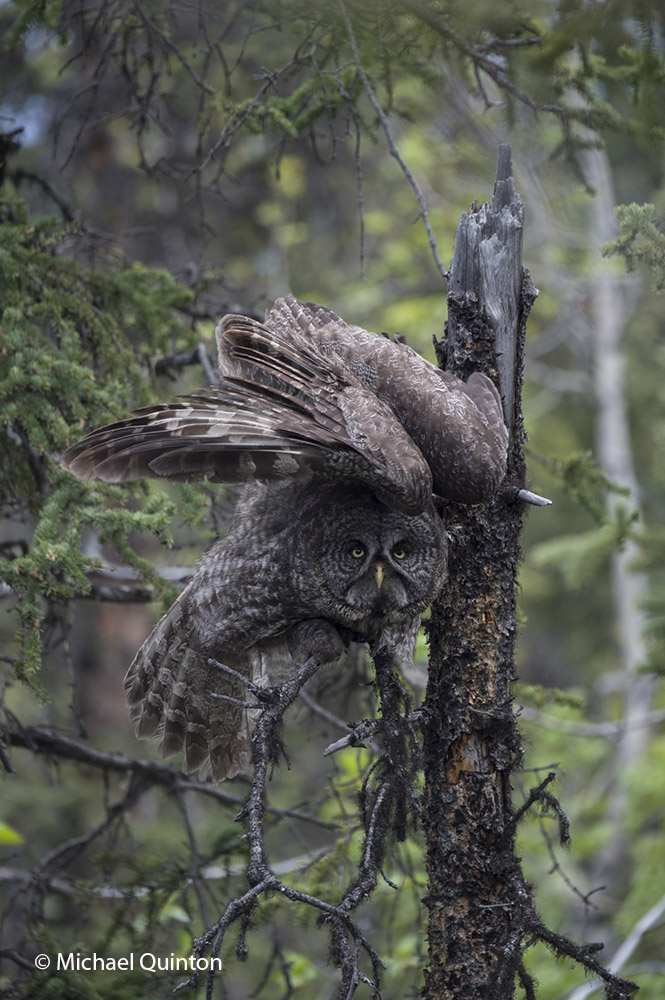 A couple of times a day the female flies off the nest to drink, cast her pellet and perhaps stretch before returning to her precious clutch of eggs.
A couple of times a day the female flies off the nest to drink, cast her pellet and perhaps stretch before returning to her precious clutch of eggs.
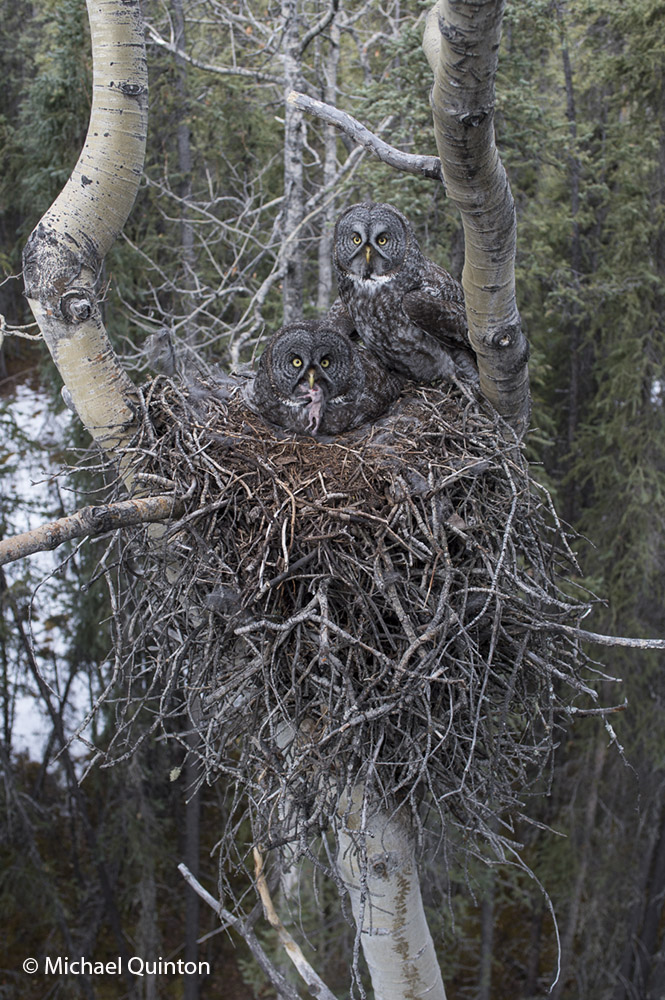 The male hunts for his mate and has just arrived with prey, a baby red squirrel. The male, who hunts during the day using sight and sound, is an opportunist and preys on a variety of small birds and mammals. Red-backed voles are by far the most important prey but shrews, small birds, and young snowshoe hares are also prey. Adult red squirrels are usually too alert and quick to be given much attention by the hunting male. But young squirrels, probably raided from their grass and sphagnum nests, are regularly on the menu.
The male hunts for his mate and has just arrived with prey, a baby red squirrel. The male, who hunts during the day using sight and sound, is an opportunist and preys on a variety of small birds and mammals. Red-backed voles are by far the most important prey but shrews, small birds, and young snowshoe hares are also prey. Adult red squirrels are usually too alert and quick to be given much attention by the hunting male. But young squirrels, probably raided from their grass and sphagnum nests, are regularly on the menu.
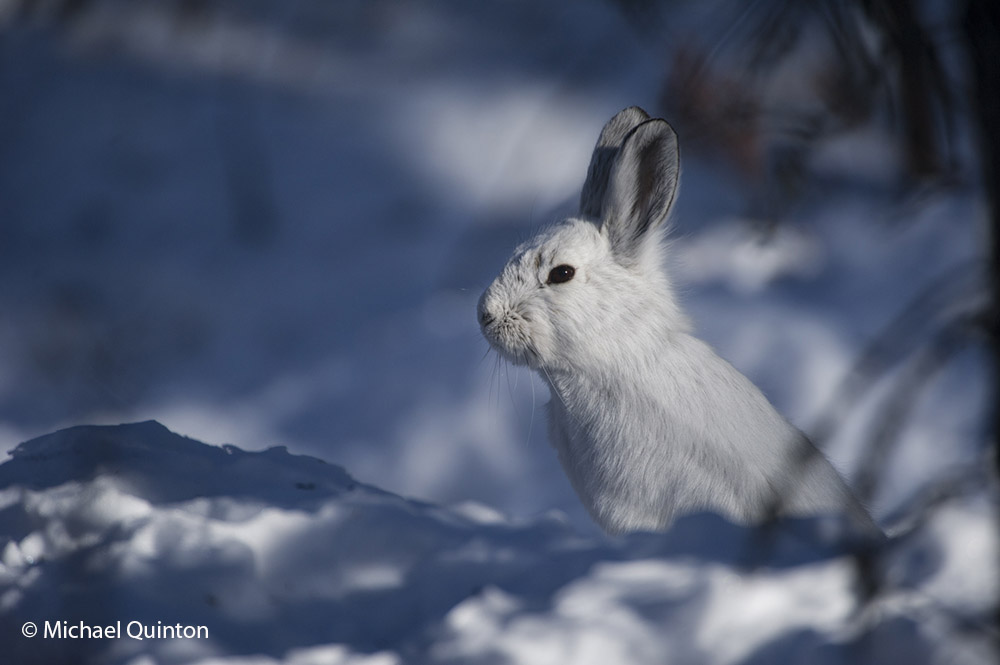 In early March, snowshoe hare (Lepus americanus) tracks began to appear where none had been all winter long. I guess the solitary males are out and about looking for females. The snowshoe hare cycle has been on the upswing for a couple of years but the hares are still uncommon in most of the black spruce forests around our place on the northern edge of Wrangell/St. Elias National Park. High quality hare habitat, mixed forests with willow and alder thickets are the nucleus of hare populations and often the only places where hares are common during low-cycle years . These “bunny patches” are where snowshoe hares multiply and disperse. A rising (or falling) hare population has a big impact on most predators and their prey. With snowshoe hare populations locally low, their main predators, lynx, red fox, northern goshawks, great horned owls and even northern hawk owls are low as well. Low numbers of predators has relieved pressure on prey species such as spruce grouse and snowshoes allowing them to recover. Grouse populations have the ability to rebound rather quickly as we have seen them do locally. All these cycles are driven to a large degree by the rise and fall of snowshoe hares. Continue reading
In early March, snowshoe hare (Lepus americanus) tracks began to appear where none had been all winter long. I guess the solitary males are out and about looking for females. The snowshoe hare cycle has been on the upswing for a couple of years but the hares are still uncommon in most of the black spruce forests around our place on the northern edge of Wrangell/St. Elias National Park. High quality hare habitat, mixed forests with willow and alder thickets are the nucleus of hare populations and often the only places where hares are common during low-cycle years . These “bunny patches” are where snowshoe hares multiply and disperse. A rising (or falling) hare population has a big impact on most predators and their prey. With snowshoe hare populations locally low, their main predators, lynx, red fox, northern goshawks, great horned owls and even northern hawk owls are low as well. Low numbers of predators has relieved pressure on prey species such as spruce grouse and snowshoes allowing them to recover. Grouse populations have the ability to rebound rather quickly as we have seen them do locally. All these cycles are driven to a large degree by the rise and fall of snowshoe hares. Continue reading
 Though unable to fly three-week old hawk owlets are ready to make the leap.
Though unable to fly three-week old hawk owlets are ready to make the leap.
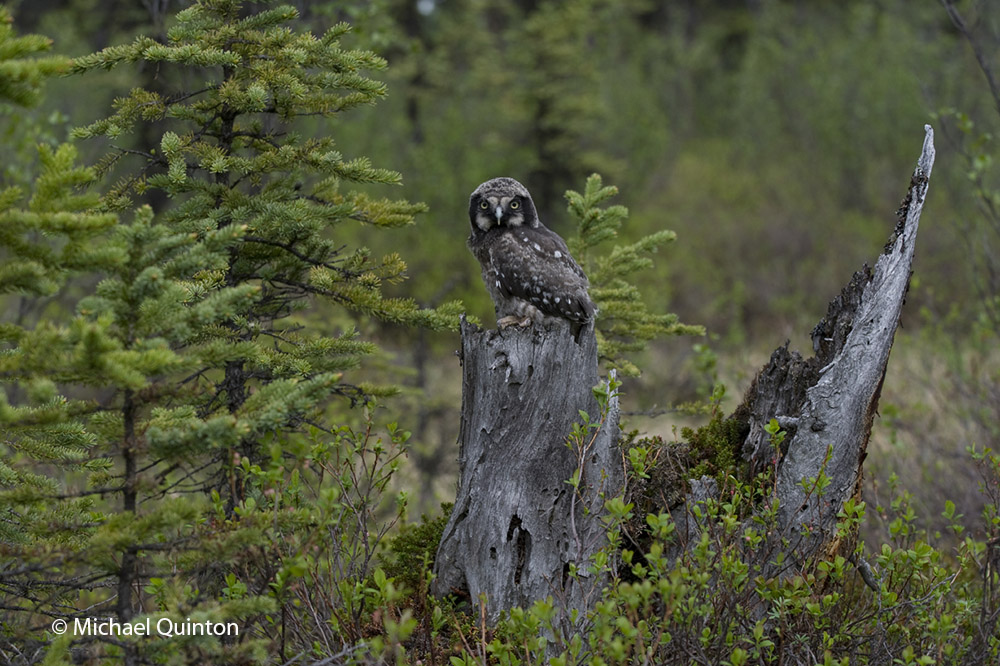 For young hawk owls the ground is a dangerous place. Continue reading
For young hawk owls the ground is a dangerous place. Continue reading